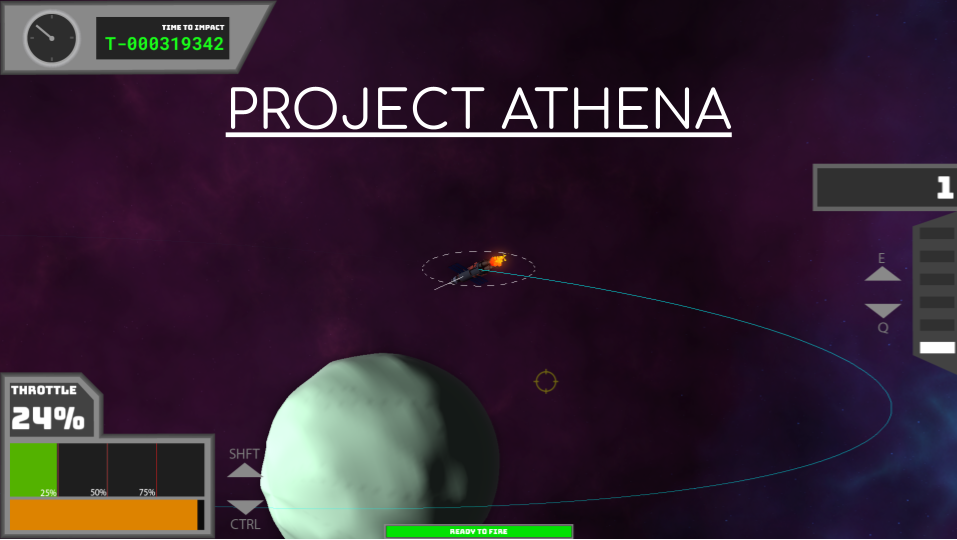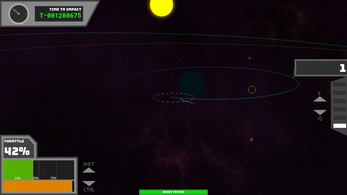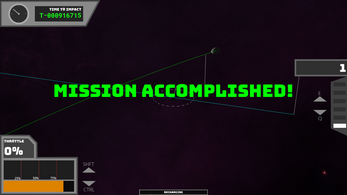
Project Athena
A downloadable game for Windows, macOS, and Linux
Project Athena is a space game operating with realistic orbital mechanics. It offers the realism displayed by games like Kerbal Space Program and Universe Sandbox while not overloading the player with the complexities and high learning curve of such games. You as the player will gain an intuitive understanding of orbital mechanics as you try to traverse the solar system in order to reach your target, an asteroid on an impact collision, in order to redirect it with an ultra-high-power laser.
How To Play:
The goal of the game is to use your laser to move the asteroid until it is no longer on a collision course. Currently, there are three levels of increasing difficulty and an in-game tutorial covering the basic controls. A more in-depth tutorial is laid out below:
- Rotate by dragging with any mouse button
- Zoom in/out using the scroll wheel
- While hovering your cursor over an object, press
TABto switch focus to that object. Pressing~will reset focus to the player.
- Uses
Qto increase time acceleration andEto decrease time acceleration. Note that player throttle and rotation controls will reset time acceleration to real-time (and similarly increasing time acceleration zeros your throttle). - When the player or asteroid is near a sphere of influence (SOI) transition between two orbits, time acceleration will automatically be decreased.
- The time remaining until the asteroid collision event is displayed at the top left corner.
- Quicksave with
F5and quickload withF9.
- Increase your rocket engine throttle with
SHFT(orW) and decrease withCTRL(orS). The UI contains a display of your current throttle and the fuel remaining in the lower left corner. - Rotate your ship using
AandD - Fire your high powered laser with
SPACEBAR. Aim with the mouse, which will automatically snap to the center of object. The UI contains a bar at the bottom center indicating if (or how-long-until) the laser is ready to fire.
- Note that the engine provides acceleration, which changes your velocity. Since space is very large it may seem like you're not moving when viewing at real-time. Try increasing time acceleration!
- The Athena laser is ultra-high-power, delivering a whopping 100 kN of force at close range. However, the laser's strength falls off by the inverse square law (just like in real life) and has a very long cooldown. Try to get as close to the target as possible before firing. If you miss, you can always time accelerate while waiting for the cooldown. The laser can be fired at any time acceleration level!
- Orbital mechanics can be confusing at the start. Unlike a more grounded environment, you don't simply fire your rocket toward where you want to go. Oversimplified:
- Burning (a.k.a fire your rocket) along your current velocity (the line tangent to the orbit) will inflate the part of the orbit on the opposite side of your location. This is known as burning 'prograde'.
- Burn against your current velocity will deflate the part of the orbit on the opposite side of your location. This is known as burning 'retrograde'.
- Burn perpendicular to your current velocity to inflate the orbit on one side (i.e. left) while deflating the other side (i.e. right). This is known as burning 'radial-in' and burning 'radial-out'.
- Note that the position you are at can highly impact how much fuel it takes to change your orbit by a certain amount! For example, it's much easier to raise the highest point of your orbit by burning prograde at the lowest point in your orbit than it is at the highest point of your orbit.
- Astrodynamics often presents excellent examples of the Butterfly Effect. A tiny change in velocity can result in massive changes in future orbit trajectories or very little at all. Even after our simplifications, there is still a sizeable learning curve and will not be easy for everyone. Quicksaving often can speed up the learning process!
Download
Install instructions
Download the `zip` file matching your operating system and unzip the file. Run the corresponding `game` executable.



Comments
Log in with itch.io to leave a comment.
Really cool game so far! I especially like the 2D orbital mechanics in a 3D setting to make it a whole lot simpler to control & understand for those learning about it.
I came across a few bugs though:
- Holding down E in an attempt to speed things up past the automatic time deceleration will cause the rocket to stop moving, drifting away from it's predicted path
- In level 2, I couldn't escape the SOI of the first planet, despite the predicted path saying otherwise. The rocket would stop just before leaving it
- I wanted to see what would happen if I didn't hit the asteroid, but before the timer ran out I got a "Mission Accomplished", despite not firing the laser
The orbital physics & the predicted path that's shown is great though (especially how it shows where you enter/exit an SOI). It would be awesome to see the entire system taken further!